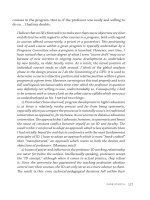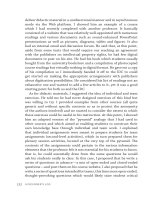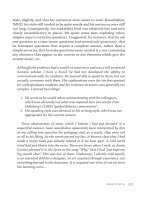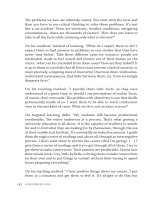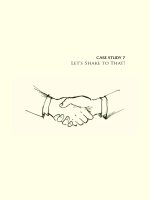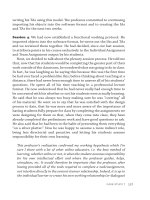A Designer’s Log Case Studies in Instructional Design- P30 pot
Bạn đang xem bản rút gọn của tài liệu. Xem và tải ngay bản đầy đủ của tài liệu tại đây (75.96 KB, 5 trang )
A D ES IG NE R' S LOG
132
deliver didactic material in a unidirectional manner and in asynchronous
mode via the Web platform. I showed him an example of a course
which I had recently completed with another professor. It basically
consisted of a website that was relatively well-appointed with numerous
readings and various documents such as sound-enhanced PowerPoint
presentations as well as pictures, diagrams, tables and gures. It also
had an internal email and discussion forum. He said that, at this point,
aside from some texts that would require our reaching an agreement
with the publishers on intellectual property rights, he had few digital
documents to post on his site. He had his book which students usually
bought from the university bookstore and a compilation of photocopied
course readings but virtually nothing in digital format. He gave me a copy
of his compilation so I immediately handed it o to the IDC to could
get started on making the appropriate arrangements with publishers
about digitisation possibilities. He considered his list of readings not an
exhaustive one and wanted to add a few articles to it, yet it was a good
starting point for both us and the IDC.
As for didactic materials, I suggested the idea of individual and team
exercises. He told me he had never designed exercises of this kind but
was willing to try. I provided examples from other courses (all quite
generic and without specic contents so as to protect the anonymity
of the authors involved) and we started to consider the extent to which
these exercises could be useful in his instruction. At this point, I showed
him an adapted version of the “pyramid” analogy that I had used in
other courses and which aimed at enabling students to construct their
own knowledge base through individual and team work. I explained
that individual assignments were meant to prepare students for team
assignments (second-level activities), which in turn prepared them for
plenary session activities, located at the very top of the pyramid. e
contents of the assignments could pertain to the various information
elements that the professor felt it was essential for his students to know,
that is, he could essentially draw from the same questions he would
ask his students orally in class. In this case, I proposed that he write a
series of questions in advance—a mix of open-ended and closed-ended
questions—and post them on his course website. I also proposed that he
write a series of questions intended for teams, this time more open-ended,
thought-provoking questions which would likely raise student critical
133
CAS E STU DY 6
thinking levels. Afterwards, I proposed that he start experimenting
with the discussion forum and attempt to deliver part of his course
in asynchronous mode. We could, however, attenuate somewhat the
“asynchronousness” of the medium by his being online at the same time
as his students, thereby being in a position to exchange messages with
them and provide almost instantaneous feedback. I knew that, given his
pedagogical style and penchant for direct verbal communication, this
was not the ideal situation for him. However, I framed it as a temporary
solution that would allow us to get the course o the ground so to speak,
while we waited for a technical solution at the receiving end that would
allow us to exploit the synchronous platform fully. He told me that he
would try the forum out to see whether it would be possible for him to
function in this manner.
Session 4: We began this session with the intent of writing an individual
assignment (IA) and a team assignment (TA). We went through the
professor's rst text together. He identied the points which were
important for the students to know and I highlighted them as we moved
along. ese highlights would allow me, rstly, to start writing up closed-
ended questions for the IA but, secondly, and perhaps more importantly,
to identify his true course objectives (which I continued to note, once
again in a discrete manner). As we moved through his text, I asked for
his feedback with regard to the questions I was writing and he adjusted
the wording accordingly.
I feel as though there is often, in the minds of a lot of professors, a degree
of confusion between writing questions based on a text (as with test
items) and writing specic objectives. I often have to explain that specic
objectives (or SOs) identify skills and knowledge, among other things,
that will enable a student to understand a text’s contents while questions
target the information contained in the text. is dierence rarely seems
obvious to professors at rst but after discussing it with them further, I am
generally able to help them understand the dierence between the two. In
fact, I often hear professors say that, after writing up their SOs, they start
noticing the same objectives (or very similar ones) popping up throughout
their course. Now that is substantial food for thought…
A D ES IG NE R' S LOG
134
Using these more close-ended individual questions as a starting point,
we then started writing up more open-ended questions intended for
the team assignment (TA). is assignment consisted of a series of
questions which were less factual in nature, more open to interpretation
and thereby likely to encourage a range of dierent answers, hopefully
even a debate among team members. ese team questions were written
according to a constructivist bent, meaning that students would be
called upon to confront the opinions, interpretations and inferences of
their peers. I thus established an assignment template of sorts for both
types of assignments that the professor could replicate once it came time
to write up assignments for his other texts. As a result of this rather
laborious process, the professor realized that, if he wanted his students
to truly understand the texts he asked them to read, he would have to
eliminate some of them. is was because the method we were in the
process of developing (IAs and TAs followed by a plenary session via
an asynchronous discussion forum and, eventually, via synchronous
desktop conferencing), while potentially benecial to his students, was
starting to appear to be prohibitively time-consuming.
We thus returned to his original course syllabus and thoroughly
examined the series of readings intended for his students. He reworked
his selection and changed the distribution sequence for the weeks of
classes. is brought us to the end of our working session. Before we
went our separate ways, the professor told me that he would send me an
IA and a TA for Week of classes before our next session.
Session 5: Since our last session, the professor had sent me, as agreed,
the IA and the TA for the second week of readings. Having had just
enough time to look at them prior to our session, we began our work
by studying them together. I had noticed that the professor tended to
write very short, specic questions such as Who did that?, What is the
term for this?, What year did this or that take place?, etc. In response, I
suggested he develop his questions further to make them a bit harder,
because his type of questions might lead students to simply exchange
answers among themselves without making an eort to nd answers on
their own. Writing questions using qualiers such as “in your own words,”
“drawing on your own experience” or “providing an example” would
reduce this risk and require that the student devote individual eort to
135
CAS E STU DY 6
nding answers. Should the professor notice systematic similarities in
his students’ answers, he could let them know that he expected individual
activities to be completed individually.
With regard to his TA, I noticed that his questions were, on the
contrary, too wordy. His sentences were, at times, simply too long and
certain portions of them, because of their complexity, lacked clarity. I
pointed out a number of examples of questions that would require some
revision. He appeared to agree with my observations.
Up to this point, his reactions have been quite reserved, as though he was
sizing me up. I was also getting the feeling that, although he was seemingly
interested in “entertaining” my input, I got the distinct feeling that I
might be invading his territory, so to speak, by means of my comments,
as though I were nonchalantly stepping on “sacred ground,” one which
none (especially mere mortals) had ever dared tread. I felt compelled to
emphasize, once again, the fact that my suggestions had to do with writing
up didactic materials from a strictly instructional standpoint, i.e. in terms
of the mental models (Gentner & Stevens, 1983) his teachings inspired in
his students, and that they had nothing to do with his academic content per
se. He told me that although he had never worked with an ID before and
that this approach was quite new to him, he was OK with the way things
were going. Indeed, he conded in me, saying that he had never spoken to
anyone (meaning his colleagues) about his course content, aside from his
students. Consequently, he admitted that our working together was both
a source of inspiration and insecurity for him. Once again, it struck me
just how precarious the ID’s situation is (professionally speaking). e ID
may inadvertently barge into an area with the best intentions in the world
only to have the door unexpectedly but rmly shut. His or her role is still
a novelty, one which is generally not acknowledged in importance. I feel as
though the ID is walking on egg shells every time he seeks to lift the veil
on the professor-centered, traditional university course planning process,
a highly individual process which seems to be rarely discussed, relatively
obscure and even expressly hidden from other faculty members.
With regard to the professor’s TA, his questions tended to closely
reproduce those in his IA, but more vague. I suggested he write TA
questions that would require his students to pool the answers they wrote
A D ES IG NE R' S LOG
136
for their IA, thereby constructing meaning on a collective scale. In order
to encourage his students to negotiate meaning, piece together elements
and ultimately draw conclusions, his TA questions would need to be more
open-ended. Consequently, we went back over his TA questions and,
rewriting them as we went, we made sure we followed the same numbering
scheme as that used in the IA. We then attacked the IA and TA for Week .
is time however, for each question in the IA, we also immediately wrote
a draft question for the TA. e latter questions required students to
carry out certain tasks such as categorising answers obtained during the
individual assignment, summarising them, analysing them in terms of
specied criteria, etc. I explained the concept of metacognition (Flavell,
) and how it applied to what we were doing. e questions we were
writing would require that students process, sort and/or piece together
the knowledge they acquired.
I also suggested that he include diagrams with his texts. e goal of
a diagram (or schematisation) is, I explained, simply to assist students
in their understanding by providing them with a “starter” mental
model. I outlined some of the research in the eld of cognitive mapping,
visualisation and mental constructs and, as a result, he expressed
interest in developing diagrams to add to his readings and assignments.
Two connected concepts in his eld of study caught our attention:
“continuity” and “rupture.” e text we were working on dealt primarily
with these two concepts but it was quite dicult. Quite spontaneously,
I sketched a diagram on the spot. We talked about the visual aspect of
the concept and we together worked on developing what I had drafted
(see how this visual representation evolved in Appendix ). After having
drawn up four versions, we agreed to think the concept over a bit more
and then ended the session.
Session 6: We began our session with another look at the diagrams,
the last version of which we decided to keep. I sent it o to the IDC so
that he could send it to the graphic artist. She would develop a more
professional-looking version (probably using Illustrator and then Flash)
and would get back to us with a prototype for our sign-o.
As we had done the last time, we began by working on the IA and the
TA that he had written between sessions using the models that I had
given him. I noticed that the professor had simplied his TA writing



